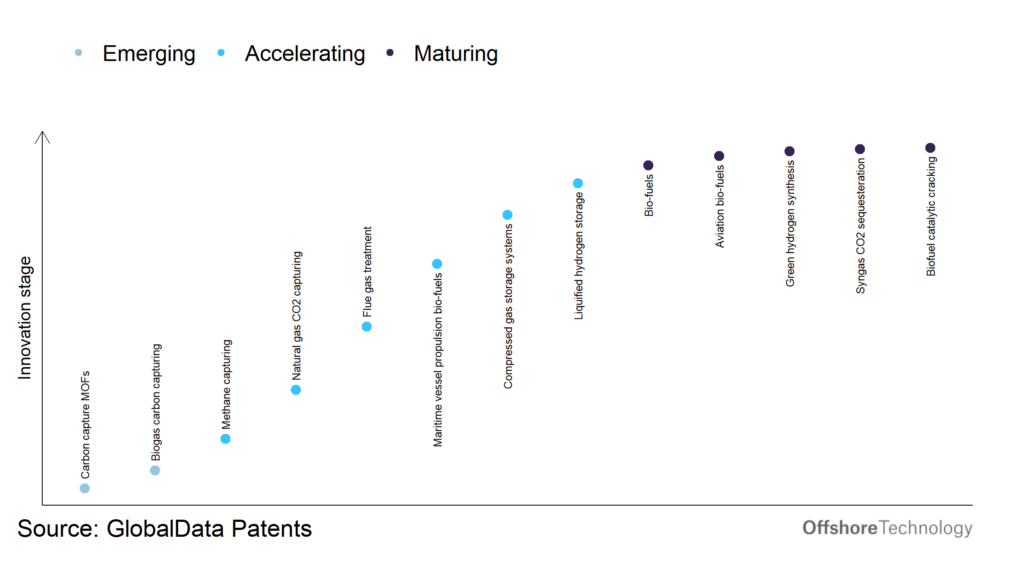[ad_1]
The oil and gas industry continues to be a hotbed of innovation, with activity driven by the need to improve operational efficiency, safety and environmental performance, and growing importance of technologies such as artificial intelligence, predictive maintenance, and digital twins. In the last three years alone, there have been over 534,000 patents filed and granted in the oil & gas industry, according to GlobalData’s report on Environment Sustainability in Oil & Gas: Natural gas CO2 capturing.
However, not all innovations are equal and nor do they follow a constant upward trend. Instead, their evolution takes the form of an S-shaped curve that reflects their typical lifecycle from early emergence to accelerating adoption, before finally stabilising and reaching maturity.
Identifying where a particular innovation is on this journey, especially those that are in the emerging and accelerating stages, is essential for understanding their current level of adoption and the likely future trajectory and impact they will have.
40+ innovations will shape the oil and gas industry
According to GlobalData’s Technology Foresights, which plots the S-curve for the oil and gas industry using innovation intensity models built on over 256,000 patents, there are 40+ innovation areas that will shape the future of the industry.
Within the emerging innovation stage, carbon capture MOFs and biogas carbon capturing, are disruptive technologies that are in the early stages of application and should be tracked closely. Methane capturing, natural gas CO2 capturing, and flue gas treatment are some of the accelerating innovation areas, where adoption has been steadily increasing. Among maturing innovation areas are bio-fuels and aviation bio-fuels, which are now well established in the industry.
Innovation S-curve for environmental sustainability in the oil & gas industry

Natural gas CO2 capturing is a key innovation area in environmental sustainability
CO2 is essentially captured before it enters atmosphere. This can be done either at pre-combustion stage, or post-combustion stage. One more method is capturing CO2 from oxy-combustion process.
GlobalData’s analysis also uncovers the companies at the forefront of each innovation area and assesses the potential reach and impact of their patenting activity across different applications and geographies. According to GlobalData, there are 40+ companies, spanning technology vendors, established oil & gas companies, and up-and-coming start-ups engaged in the development and application of natural gas CO2 capturing.
Key players in natural gas CO2 capturing – a disruptive innovation in the oil and gas industry
‘Application diversity’ measures the number of different applications identified for each relevant patent and broadly splits companies into either ‘niche’ or ‘diversified’ innovators.
‘Geographic reach’ refers to the number of different countries each relevant patent is registered in and reflects the breadth of geographic application intended, ranging from ‘global’ to ‘local’.
ExxonMobil, a leading patent filer, has successfully captured 120M metric tons of carbon dioxide. The company has also collaborated with University of California to design and develop a new metal-organic framework material for CO2 capturing.
Air Liquide Engineering and Construction, another key patent filer, uses a Cryocap that operates under low temperatures to reduce CO2 emissions by 90% during hydrogen production while simultaneously boosting the production of hydrogen by 20%.
Honeywell International is using its technologies to capture 1.65M tons of CO2 annually from a gasification plant, while simultaneously producing clean hydrogen energy.
CO2 capturing is increasingly becoming a necessity for many oil and gas companies as they continue to seek to reduce emissions from their operations. New innovations and technologies in CO2 capturing will help companies to cut dangerous emissions and mitigate climate change.
To further understand the key themes and technologies disrupting the oil & gas industry, access GlobalData’s latest thematic research report on Top 20 Oil & Gas Themes 2022.
[ad_2]
Source link








